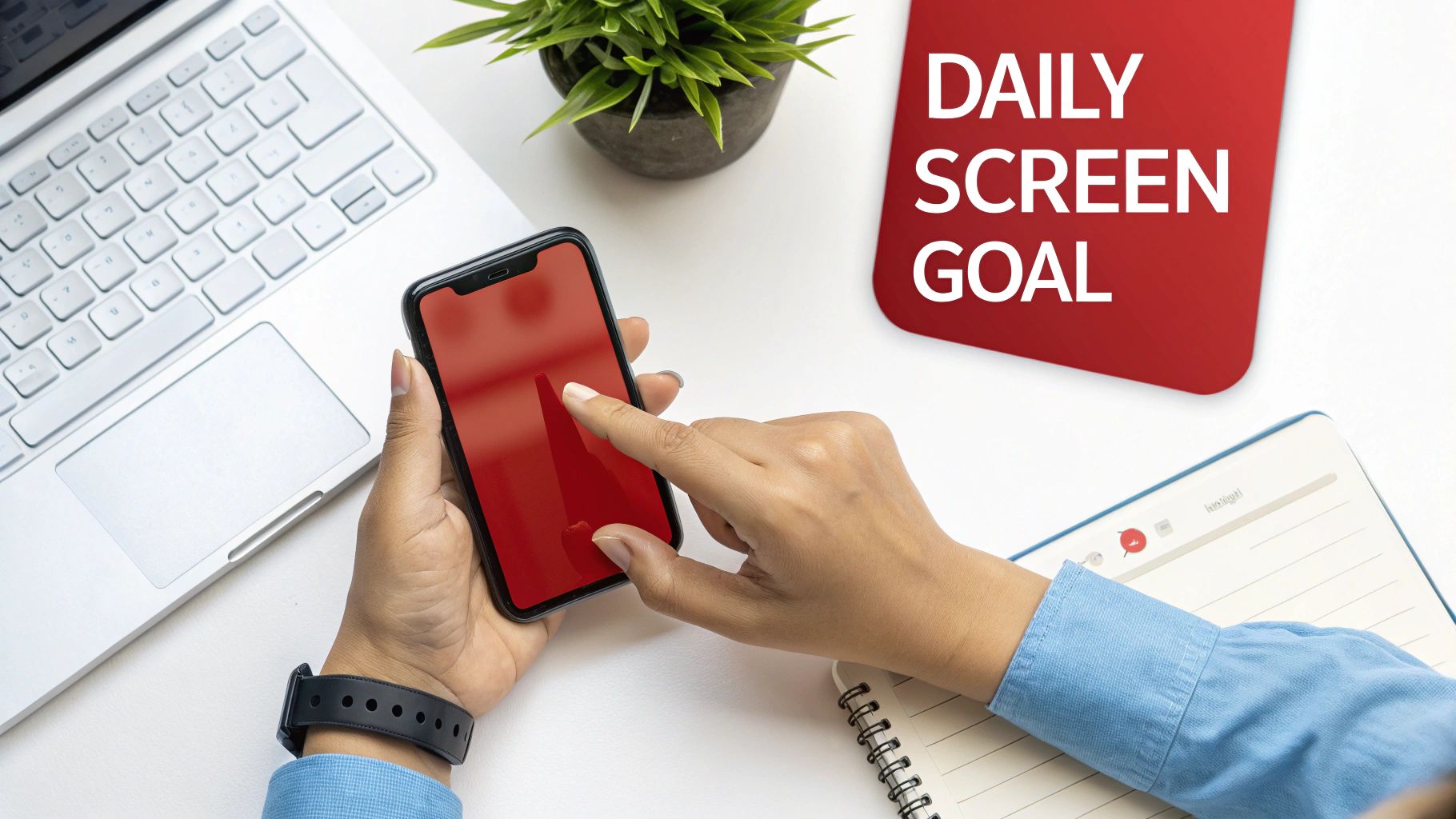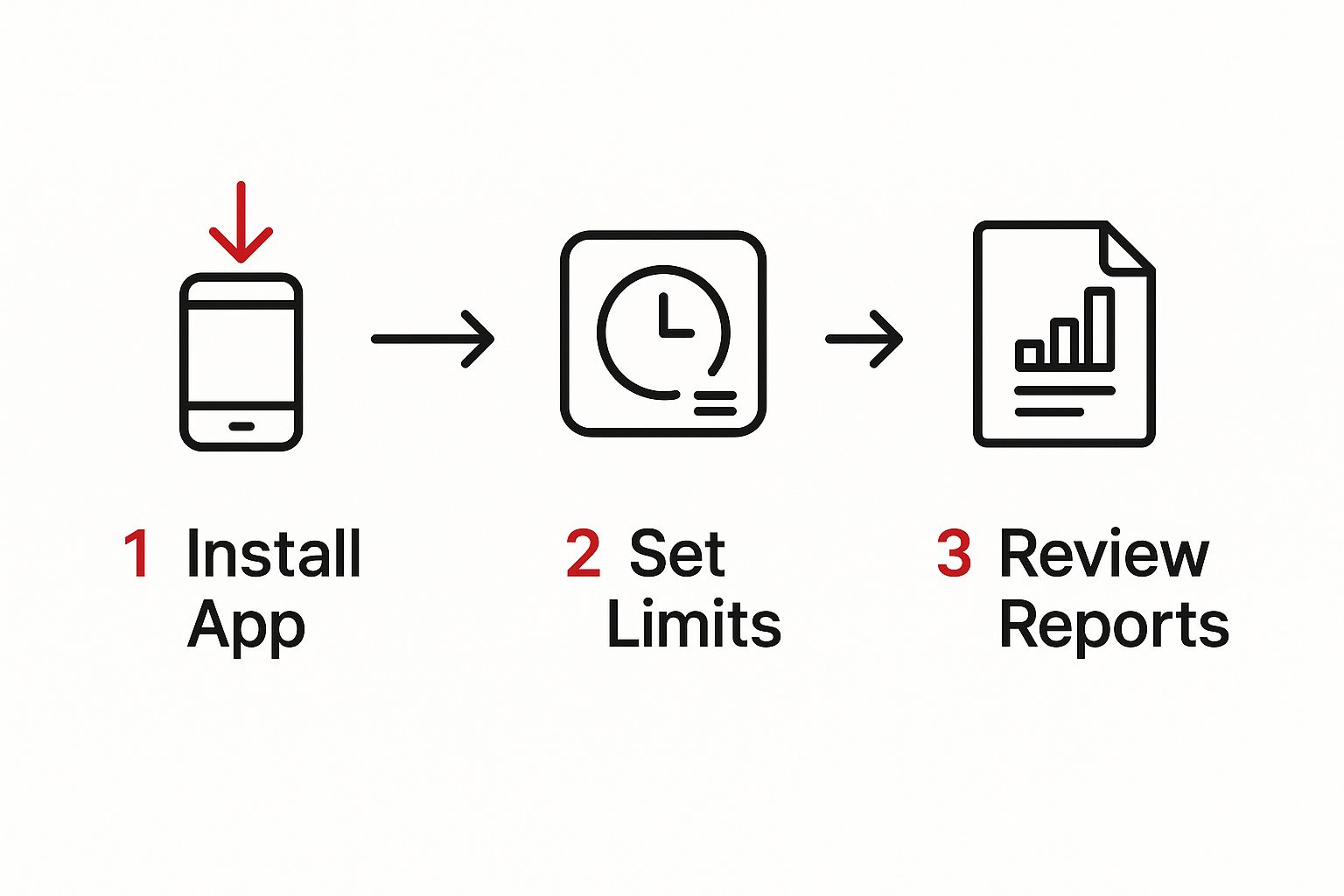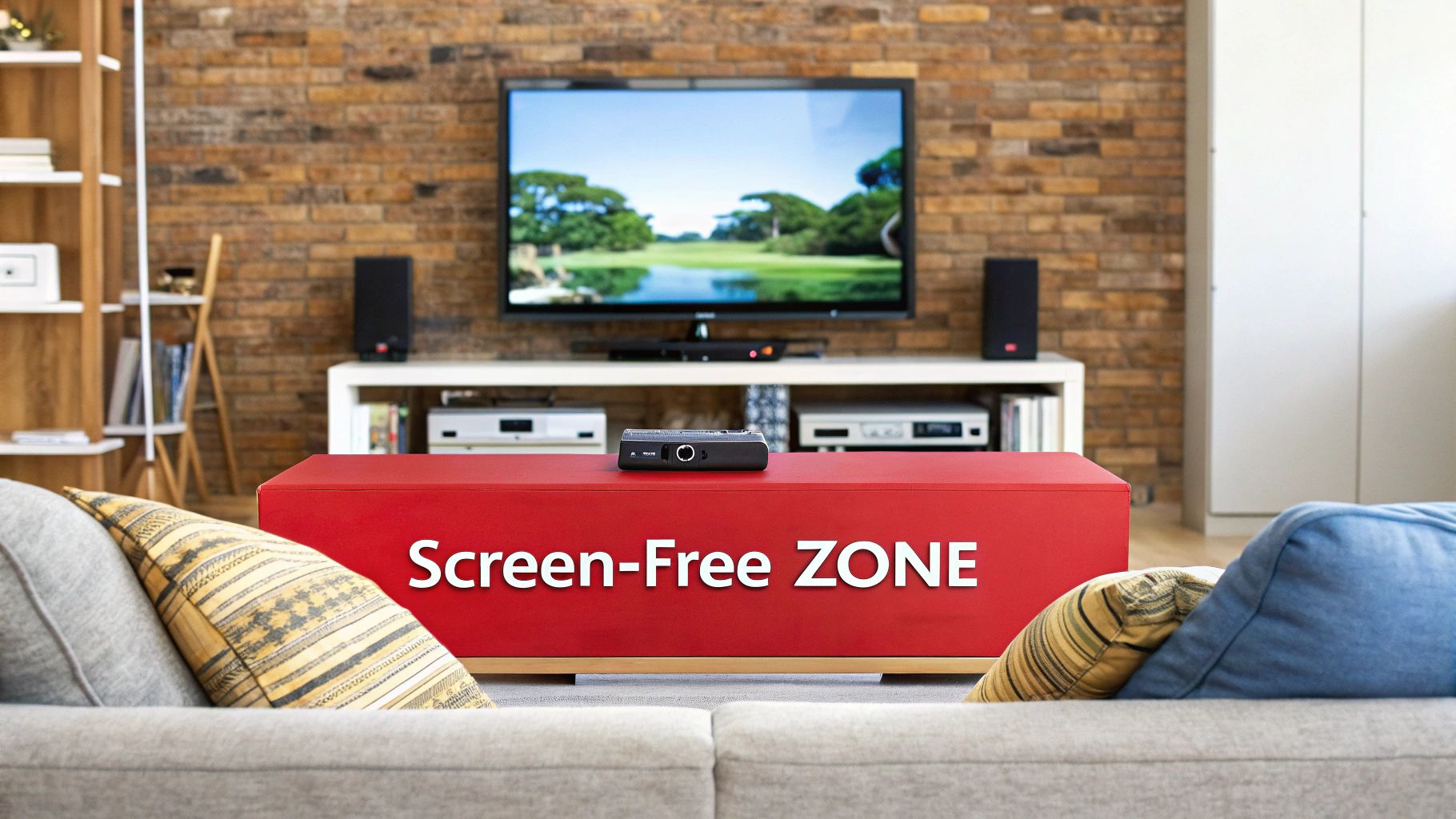
How to Limit Screen Time: A Parent's Practical Guide
Does the family dinner conversation get drowned out by the glow of a few too many screens? If you’re nodding along, you are definitely not alone. It’s a scene playing out in homes everywhere, and that nagging frustration is a battle countless parents are wrestling with.
And honestly, it’s a tough one. These devices are engineered to capture our attention, serving up an endless buffet of entertainment that’s hard for anyone to turn down—kids and adults included. The goal here isn't to demonize technology or turn your home into a tech-free zone. It's about finding a practical way to live with screens intentionally, creating a healthy balance that actually works for your family.
Why Finding a Healthy Balance is So Crucial
This isn't just a feeling; the numbers show that managing screen time is more important than ever. The daily average is climbing worldwide. By 2025, it’s expected to hit around 6 hours and 40 minutes a day—a jump of more than 30 minutes since 2013.
In the US, the average person already spends about 7 hours and 3 minutes glued to a screen each day. And it’s starting younger, with nearly half (49%) of all children between 0 and 2 already using smartphones. You can dig into more of the latest screen time statistics to see how this trend is shaping families across the globe.
Key Takeaway: The goal isn’t a total digital detox. It’s about finding a digital equilibrium—making sure technology is a tool that serves your family, not the other way around.
This guide is designed to move you past the guilt and provide a practical, non-judgmental game plan. We'll walk through real, actionable strategies to help you reclaim precious family time and build healthier habits, all without turning every day into a power struggle. Let’s build a family life where screens have their place, but they don't run the show.
Build Your Family Media Plan as a Team

Let's be real: dictating screen time rules from on high usually leads to one thing—rebellion. To avoid a power struggle, the best approach is to create a Family Media Plan as a team.
When you bring your kids to the table, the entire conversation shifts. It’s no longer about top-down commands. It becomes a collaborative effort where they have a voice and a sense of ownership over the rules. Once they understand the "why" behind the boundaries, their willingness to cooperate skyrockets. You're not just setting limits; you're teaching them the lifelong skill of self-regulation.
Define Your Tech-Free Zones and Times
The easiest place to start your family meeting is by defining the "when" and "where" of screen use. Nailing down tech-free zones and times can make a massive impact on family connection and they're often the easiest wins.
Kick off the discussion by talking about which spaces and moments should be protected from digital distractions.
- The Dinner Table: This is a classic for a reason. Keeping mealtimes screen-free opens the door for genuine conversation and lets everyone reconnect.
- Bedrooms: Making bedrooms a no-tech zone is a game-changer for healthy sleep. The blue light from screens can interfere with melatonin production, making it harder to wind down and rest.
- One Hour Before Bed: This is a fantastic rule for the whole family. It gives everyone’s brain a chance to switch off, leading to better rest and a more peaceful evening.
This isn't about punishment. It’s about being intentional with your time and creating space for rest and real interaction. When you agree on these zones together, they feel less like restrictions and more like shared family goals.
Pro-Tip: A Family Media Plan isn't about control; it's a shared agreement built on mutual respect. It teaches kids to think critically about their own tech habits, a skill they will carry into adulthood.
Focus on Quality Over Quantity
Not all screen time is created equal, and this is a crucial part of the conversation. There’s a world of difference between passively scrolling through short-form videos and actively creating digital art or learning to code. Your role here is to guide them toward more meaningful digital experiences.
Sit down together and talk about the "what." You can categorize different screen activities. Things like watching an educational documentary, learning a new language, or using an app to compose music fall into a totally different bucket than just watching other people play video games. This is where concepts like discovery-based learning come in, as they prioritize curiosity and active engagement over passive consumption.
By framing the conversation this way, you empower your kids to make smarter choices. It’s no longer just about “how long” they’re on their devices, but “what” they are doing with that time. This simple shift helps them see technology as a tool for creativity and learning, not just a toy for entertainment.
Our Family Media Plan Template
To make this process even easier, use this simple template. The goal is to get everything down in writing so there's no confusion later. Grab a piece of paper or open a document and work through this as a family.
| Area of Focus | Our Family Rule | Why This Is Important to Us |
|---|---|---|
| Tech-Free Zones | e.g., No phones or tablets at the dinner table. | e.g., So we can talk about our day without distractions. |
| Tech-Free Times | e.g., All screens off one hour before bedtime. | e.g., To help our brains relax and get better sleep. |
| Quality Content | e.g., We will spend time on apps/games that are creative or educational. | e.g., Because we want to use tech to learn new things. |
| Digital Kindness | e.g., We will only say things online that we would say in person. | e.g., To be respectful and kind to everyone. |
| Asking First | e.g., We'll ask a parent before downloading a new app or game. | e.g., To make sure what we're using is safe and appropriate. |
Once you've filled it out, post it somewhere visible, like the fridge. This isn't just a list of rules; it's a living document that represents your family's shared commitment to a healthy relationship with technology.
Practical Strategies to Cut Down on Daily Screen Use
Okay, you’ve got a solid Family Media Plan. That’s a huge first step! Now, let's turn that plan into action. These are the everyday tactics that work time and again to reduce screen use without turning your home into a warzone. The secret is making your environment work for you, not against you.
One of the most powerful principles is also the simplest: ‘out of sight, out of mind.’ It’s human nature. When phones, tablets, and gaming controllers are just lying around, they become the default activity. A designated "device drop-off" spot—like a basket by the door or a kitchen drawer—can work wonders to curb that mindless pickup habit.
Let Digital Wellbeing Tools Do the Heavy Lifting
Instead of playing the role of the constant timekeeper (which is exhausting), let technology handle the enforcement. Both iOS and Android phones have powerful, built-in digital wellbeing tools that can automate the rules you’ve all agreed on. It takes just a few minutes to set them up, but it saves you countless hours of nagging and negotiating.
Getting started is pretty straightforward.

This cycle of installing, setting, and reviewing creates a great feedback loop for building healthier habits. You can use these features to enforce your Family Media Plan automatically.
- Set App Timers: Assign daily time limits for the real time-suckers, like social media or specific games. When the time is up, the app gets blocked. Simple as that.
- Schedule Downtime: This feature makes devices unavailable during key periods, like the hour before bed or during homework. It’s the perfect way to enforce those tech-free times you agreed on.
Key Takeaway: Using these built-in features completely changes the dynamic. It’s the phone enforcing the rules, not you. This removes the personal conflict and seriously reduces power struggles.
These tools make a real difference. With mobile devices now accounting for nearly half of all global screen time, more people are turning to features like iOS Screen Time. Studies have found that people who use these tools can cut their daily social media consumption by as much as 25%, a huge win for focus and family time.
Master the Art of the Transition Warning
Here’s another game-changer, especially with younger kids: the 'Transition Warning.' Abruptly telling a child to turn off a device can feel like a shock to their system and is a classic trigger for meltdowns. A simple heads-up prevents this almost every time.
About five or ten minutes before screen time is scheduled to end, just give a calm, clear warning. Something like, “Hey, you have five more minutes to finish up your game,” does the trick. This small gesture gives them a sense of control and helps them mentally prepare to switch gears.
When the time is actually up, the transition is much smoother because it’s not a surprise. This technique works even better when you have one of your family’s favorite hands-on learning activities ready to go. That way, the end of screen time doesn't feel like a punishment; it just signals the start of something else fun. Consistency is key—over time, your child will learn the routine, and those screen-time battles will become a thing of the past.
Make Offline Activities More Appealing
Let's be honest: just yanking the tablet away isn't going to cut it. If you want to truly dial back screen time, you have to offer something better. The goal isn't to make screen time a forbidden fruit but to make offline time so genuinely fun that it becomes the preferred choice.
This is all about shifting the family focus from 'less screen time' to 'more real-life fun.' You're not just telling them to go play; you're creating an environment that practically begs for hands-on exploration and connection.

Create a "Curiosity Corner"
A simple but effective strategy is to set up a dedicated, screen-free zone in the house. Call it a "Curiosity Corner" or an "Inventor's Nook"—the name doesn't matter. What matters is that it's packed with things that spark imagination.
This doesn't have to be some elaborate, Pinterest-perfect setup. It can be as simple as a shelf in the living room or a designated basket filled with irresistible, hands-on materials that are always visible and ready to go.
Here’s what you might stock in your corner:
- STEM Kits: A kitchen-safe chemistry set is a huge win. Or, try an electronics kit for building a simple circuit. These provide hours of guided fun.
- Art Supplies: Keep the basics on hand—paper, paints, clay, and even recycled materials—for those sudden bursts of creativity.
- Building Toys: You can't go wrong with the classics. LEGOs, magnetic tiles, or a good old set of wooden blocks are fantastic for problem-solving.
Rotating the items every few weeks keeps the space feeling fresh and exciting.
Pro-Tip: The real magic happens when you reframe the narrative. Instead of "You can't have your tablet," the message becomes, "Let's see if we can make this volcano erupt!" The shift from restriction to invitation changes everything.
Spark Excitement with Family Challenges
Another game-changer is turning offline activities into a friendly competition. A little collaboration and rivalry can transform a simple afternoon into an event the whole family looks forward to.
For example, you could host a weekly or monthly family "Inventor's Challenge." Grab a Playz science kit and set a mission: build the tallest tower, design a gadget that actually works, or create the most spectacular (and safe!) chemical reaction.
This approach works for a few key reasons:
- It Builds Teamwork: Working toward a common goal is an incredible bonding experience.
- It Makes Learning Stick: Kids absorb concepts so much better when they’re actively applying them in a fun, low-pressure way.
- It Creates Memories: These are the moments that stick. An afternoon spent laughing over a failed experiment is far more memorable than one spent on separate devices.
When you make these activities a core part of your family culture, you're teaching your kids that the most rewarding fun happens in the world around them, not just on a screen.
Lead by Example With Your Own Digital Habits
Kids have a superpower for spotting hypocrisy. They see us telling them to put their tablets away while we’re glued to our own phones, and they absolutely notice when our words and actions don't match up.
This is why the single most powerful strategy for teaching healthy screen habits has nothing to do with rules or timers—it’s about what we do. It all comes down to modeling the behavior we want to see.
An honest look at your own digital habits can be eye-opening. How often do you check notifications during a family movie? Or fire off a "quick" email while your child is telling you about their day? This modern problem has a name: "technoference." It’s what happens when our device use accidentally cuts into precious family moments, sending a clear message: whatever is on this screen is more important than the person right in front of me.

The good news is that making small, intentional changes can completely reshape this dynamic. You can show your children what a balanced relationship with technology really looks like, one small action at a time.
How to Be a More Present Parent
Being more present doesn't mean you have to ditch your phone entirely. It's about being more mindful.
One simple habit is to narrate your necessary tech use. Saying something like, "I'm just looking up the directions to the park," or, "Hold on, I need to text Grandma back about dinner," provides important context. It shows your kids you’re using your device as a tool, not just for mindless scrolling.
Here are a few other actionable ways to lead by example:
- Establish Your Own No-Phone Zones: Make a personal commitment to put your phone away during meals and conversations. The first 30 minutes after you get home is another great time to disconnect from work and reconnect with family.
- Practice Active Listening: When your child is talking to you, physically put your device down. Turn to face them. Make eye contact. This small act tells them they are seen, heard, and valued.
- Schedule Your Screen Time: Just as you do for your kids, set aside specific times to check emails or social media. This stops it from bleeding into every spare moment of your day.
Key Takeaway: The goal isn't parental perfection; it's progress. Modeling a healthy, intentional relationship with technology will teach your children more than any lecture or rule ever could.
Recent data shows a slight but hopeful trend. The global average for daily screen time has actually decreased by about 20 minutes since its peak in 2021. This suggests that more people are becoming aware of their habits and starting to reclaim their time—a powerful lesson to pass on to the next generation.
By demonstrating mindful tech use, you also open the door for more engaging, screen-free activities. Instead of just passively consuming content on separate screens, you can actively create and learn together. For instance, you could explore how technology works away from a screen with something like the Playz My First Coding & Computer Science Kit, turning a conversation about tech into a hands-on adventure.
Answering Your Top Screen Time Questions
Even with a solid game plan, you're going to run into tricky situations. Figuring out screen time isn't a "set it and forget it" task, and it's totally normal to have questions pop up along the way.
Here, we tackle some of the most common hurdles parents face, with real, actionable advice to help you handle them with confidence.
How Much Screen Time Is Too Much for My Child?
This is the most common question, and the truth is, there's no single magic number that works for every child. The "right" amount depends on your child's age and, more importantly, the quality of what they're doing. Instead of getting hung up on exact minutes, focus on overall balance.
A good rule of thumb is to make sure screens aren't crowding out the essentials of a healthy childhood. Ask yourself:
- Sleep: Is my child getting 8-10 hours of quality rest every night?
- Activity: Are they getting outside for at least an hour of physical play each day?
- Connection: Are screens displacing homework, family dinners, or in-person time with friends?
Your Family Media Plan is the perfect place to define what this balance looks like. For children under two, screen time should be minimal and always co-viewed with a parent. For preschoolers (ages 2-5), aiming for about an hour of high-quality, educational programming is a great starting point.
What if My Child Gets Angry When I Enforce Limits?
Pushback is completely normal, especially when you’re introducing new rules. The key is to respond with calm consistency. Your reaction sets the tone for how these moments will unfold in the future.
First, always acknowledge their feelings. A simple, "I know it's frustrating to stop playing when you're having fun," goes a long way. It shows you understand and validates their feelings without caving. Then—and this is critical—you must hold the boundary firm.
Pro-Tip: Consistency is your greatest ally. When kids see that the rules are predictable and non-negotiable, the arguments and tantrums will gradually fade. It builds a foundation of respect for the limits you’ve set together.
This is where giving transition warnings is a game-changer. Even better? Have an awesome offline activity ready to go. When "screens off" means it's time for a fun board game or a cool science experiment, it reframes the entire experience from a punishment to just the next fun thing.
Is All Screen Time Considered Bad?
Absolutely not. The goal isn't to eliminate technology but to help our kids become mindful, intentional users. It's the context and quality of the screen time that really count. There’s a massive difference between passively scrolling through endless short-form videos and actively engaging with a screen.
For example, video-calling Grandma, creating digital art, researching a school project, or learning to code are all active, productive forms of screen time.
You can encourage this by taking a genuine interest in what they're creating or learning online. Use your family plan to draw a clear line between these different categories, and set firm limits on the passive stuff. For more answers to common parenting questions, you can also explore our Frequently Asked Questions page.
Ready to fill your home with laughter, curiosity, and screen-free fun? Playz offers a world of hands-on science kits and creative toys designed to spark imagination and make learning an adventure. Explore our collection and discover the perfect way to reconnect with your kids at https://www.playzusa.com.
